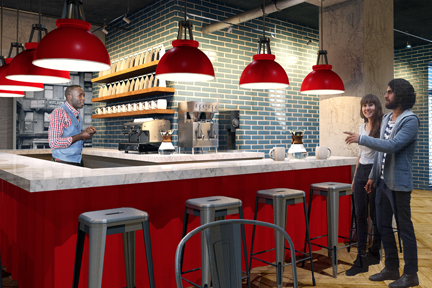
Developer Jassen Johnson’s Renaissance Development Group has applied for an $8 million zoning only permit to convert the vacant Beaumont Telephone Exchange into apartments and offices. The mixed use redevelopment of the long-vacant structure will transform it into the Midtown Malone.

Over the past decade and a half, Johnson has driven the resurgence of Midtown Alley. He is now focusing his energies on weaving back together Midtown and Downtown West. Billed as the Jefferson Connector, Johnson envisions a series of projects that will create a hub of life and activity at the juncture of the two neighborhoods. Johnson began renovation of the historic Mendenhall building on Locust east of Jefferson last year, anchored by integrated marketing company Scorch. Renamed the Martin, tenants are already moving in. Johnson also recently completed the first phase of a redevelopment across Locust from the Beaumont.

Johnson closed on the purchase of the Beaumont Exchange at 2654 Locust last year. Previous reports have identified his partner as Downtown-based Twain Financial Partners. Plans are to convert the 100,000 square foot Beaumont into 60 apartments as well as creative office and coworking space.


The property is listed on the National Register of Historic Places and is therefore eligible for state and federal historic tax credits. Known colloquially as the “Bomont Branch,” the classical revival Beaumont was designed in 1902 by noted architectural firm Eames & Young. Constructed of concrete and steel sheathed in brick and terra cotta, the structure varies from three to six stories. Additions in 1921, 1925 and 1946 enlarged the building, giving it an E-shaped footprint with bays surrounding light well courtyards. Entrances are off the courtyards.


The Beaumont was one of several telephone exchanges built in the run up to the 1904 St. Louis World’s Fair, and it was the most technologically advanced communications center at the time. A 1903 article in the St. Louis Republic stated, “Beaumont exchange, at Beaumont and Locust streets, the last branch constructed, is said to be one of the best equiped [sic] of modern exchanges.” The open floorplan supported by Doric columns allowed for long switchboards from which operators would connect calls. At the Fair, Alexander Graham Bell boasted that boards like those in the Beaumont could manage 9600 telephones and could include 4000 miles of wire inside the board, “enough if stretched in one long line to reach from St. Louis to Liverpool.” The Beaumont is the only surviving long-distance Bell Telephone exchange in St. Louis.

Outside, the Beaumont is richly detailed. Around the top of the original 1902 building, lion-headed gargoyles project from the cornice above an elaborate arched window opening.

Another developer’s 2014 attempt to transform the Beaumont into seventy market rate apartments failed to gain traction. Johnson plans for construction to start this Spring. Interior exploratory demolition has already begun.

Future plans call for an adjacent parking garage with a boutique hotel at Jefferson and Locust. Combined, the projects along the 2600 block of Locust will be dubbed Midtown Village. Together with the Mendenhall, the projects combined could cost $55 million.
